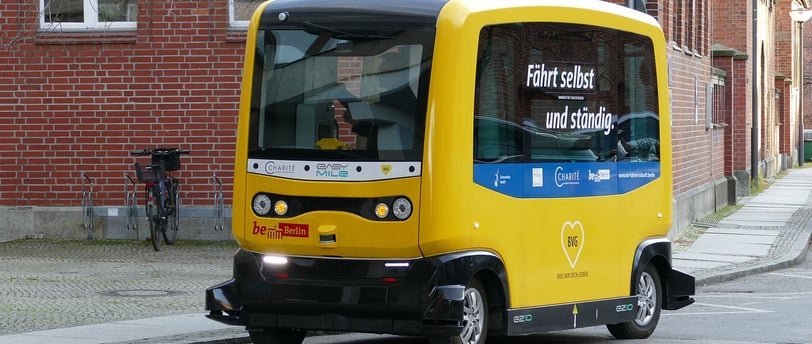Windway Logistics | Logistics and Transportation Solutions
How Autonomous Delivery Bots Are Transforming Urban Logistics
Explore the growing role of autonomous delivery bots in improving last-mile delivery for urban areas.
9/20/20244 min read


Introduction
The transportation sector is experiencing a major shift, propelled by the emergence of self-driving delivery vehicles. These vehicles are playing a crucial role in streamlining last-mile delivery and transforming the way goods are moved in cities. As urban areas become more crowded and the demand for quicker delivery services grows, self-driving delivery solutions present a viable approach to enhance efficiency, cut costs, and improve customer satisfaction. In this piece, we will delve into how the automation of the final delivery phase is shaping the future of city deliveries and its implications for the transportation industry.
1. The Emergence of Self-Driving Delivery Vehicles
Self-driving delivery vehicles are autonomous robots designed to transport items to customers in city settings. Equipped with sensors, cameras, and artificial intelligence (AI), these vehicles can navigate through sidewalks, streets, and even buildings to safely and efficiently deliver packages. As online shopping increases and the demand for fast, contactless delivery rises, these vehicles are becoming a key part of contemporary city logistics.
Key Characteristics of Self-Driving Delivery Vehicles:
- AI-driven navigation: These vehicles use AI to plan routes, avoid obstacles, and interact with their surroundings in real-time.
- Contactless delivery: With safety in mind, these vehicles offer contactless delivery, minimizing face-to-face interactions and reducing the risk of spreading illnesses.
- Electric and sustainable: The majority of these vehicles are powered by electricity, making them a sustainable option for deliveries in cities.
2. Last-Mile Automation: The Future of City Delivery
The final leg of a product's journey, from the warehouse to the customer's doorstep, is often the most costly and inefficient part of the delivery process. The automation of the last-mile using self-driving delivery vehicles provides a solution to this issue by optimizing deliveries in crowded city areas.
Advantages of Last-Mile Automation:
- Faster delivery times: These vehicles can maneuver through busy city streets more efficiently than conventional delivery trucks, thereby reducing delivery times.
- Cost savings: By decreasing the need for human drivers and vehicles, companies can lower their labor and fuel expenses.
- Enhanced scalability: These vehicles operate around the clock, allowing logistics companies to expand their delivery services without the need for additional staff.
3. The Evolution of Urban Logistics and the Call for Innovation
With the swift expansion of cities and the increase in traffic congestion, traditional delivery methods encounter significant obstacles in urban logistics. The introduction of self-driving delivery vehicles is tackling these issues directly by offering a more adaptable and efficient delivery system. These vehicles are especially well-suited for city settings where short-distance deliveries are frequent, and traditional vehicles struggle with parking, traffic, and limited access.
How Autonomous Bots Address Urban Challenges:
- Traffic congestion: Delivery bots can bypass traffic by using sidewalks and pedestrian pathways, reducing delays caused by road congestion.
- Limited parking: In densely populated urban areas, finding parking for delivery vehicles can be difficult. Autonomous bots, however, require no parking space, allowing them to deliver directly to doorsteps.
- Eco-friendly solutions: Many cities are pushing for greener delivery methods to reduce their carbon footprint. Autonomous delivery bots, which are electric-powered, offer a sustainable alternative to fuel-driven delivery trucks.
4. Enhanced Customer Experience
Autonomous delivery bots not only benefit logistics companies but also enhance the customer experience. As consumers increasingly expect fast, same-day, or even same-hour delivery, last-mile automation ensures that companies can meet these demands without compromising on service quality. Bots can deliver packages directly to customers' homes, offices, or other designated locations, offering a more seamless delivery process.
Customer Benefits of Autonomous Delivery Bots:
- Faster deliveries: With round-the-clock operation and the ability to navigate through busy streets quickly, customers can receive their orders in less time.
- Real-time tracking: Many delivery bots come with real-time tracking capabilities, allowing customers to monitor their package’s journey from start to finish.
- Convenient delivery options: Autonomous bots can deliver to precise locations, such as apartment doors or specific office rooms, enhancing delivery accuracy and convenience.
5. The Role of AI and Machine Learning in Autonomous Deliveries
Artificial intelligence (AI) and machine learning play a pivotal role in powering autonomous delivery bots. These technologies enable the bots to learn from their surroundings, improve their route efficiency, and avoid obstacles like pedestrians, cyclists, and vehicles. AI also helps bots optimize their deliveries, ensuring that they take the fastest, safest, and most efficient routes.
AI and Machine Learning in Action:
- Obstacle detection: Bots use AI to detect and avoid obstacles such as pedestrians, street furniture, and traffic, ensuring safe deliveries.
- Route optimization: Machine learning algorithms analyze traffic patterns, weather conditions, and other variables to optimize delivery routes in real time.
- Autonomous decision-making: AI allows delivery bots to make real-time decisions, such as choosing alternate routes when faced with roadblocks or delays.
6. Regulatory and Safety Considerations
As autonomous delivery bots become more common in urban logistics, regulatory frameworks must evolve to accommodate this technology. Ensuring that these bots operate safely and within the boundaries of the law is essential for widespread adoption. Many cities are already introducing pilot programs to test delivery bots, ensuring they meet safety standards and regulatory requirements.
Key Regulatory Concerns:
- Pedestrian safety: Autonomous bots must navigate sidewalks and crosswalks without posing a risk to pedestrians.
- Traffic laws: Bots must comply with local traffic laws, such as yielding to pedestrians and obeying traffic signals.
- Data privacy: Since delivery bots rely on cameras and sensors to navigate, ensuring that they do not infringe on individuals' privacy is critical.
7. The Future of Autonomous Delivery in Urban Areas
As autonomous delivery bots continue to evolve, they are poised to become a staple of urban logistics. From small packages to groceries, these robots will handle an increasing portion of last-mile deliveries, driving efficiency and reducing environmental impact. Additionally, as AI technology improves and regulations adapt, the scalability of these bots will further accelerate their adoption in cities worldwide.
Predictions for the Future:
- Wider adoption: More cities will implement autonomous delivery bot programs, particularly as e-commerce continues to grow.
- Increased use cases: Beyond small packages, autonomous bots may soon be able to handle larger and more complex deliveries, further streamlining urban logistics.
- Integration with smart cities: As cities become more connected, autonomous delivery bots will integrate with other smart city technologies, improving overall efficiency and sustainability.
Conclusion
Autonomous delivery bots are transforming the landscape of urban logistics by offering a more efficient, scalable, and environmentally friendly solution for last-mile delivery. With the ability to reduce costs, improve customer satisfaction, and navigate congested urban environments, these bots represent the future of city-based deliveries. As technology advances and regulatory frameworks catch up, last-mile automation will continue to revolutionize the logistics industry, paving the way for faster, smarter, and greener urban deliveries.
Your One-Stop Shop for Logistics Solutions.
Contact
Follow
Support@windwaycentralogistics.com
+2347069986074
© 2024. All rights reserved.
+2347042141892
+233540806857
* Badagry expressway, Alafia Bus stop, behind Oando filling station( Bencord Warehouse),Lagos, Nigeria.
* Atiku Abubakar Hall, Balogun Trade Fair market, Lagos, Nigeria
* Abossey-Okai Mortuary Road, Opposite the Central Mosque, Ghana.


